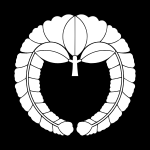
Back فوجيوارا (عشيرة) Arabic Фудзівара (род) Byelorussian Klann Fujiwara Breton Clan Fujiwara Catalan Fudžiwara Czech Fujiwara (Familie) German Αδελφότητα Φούτζιγουαρα Greek Clan Fujiwara Spanish Fujiwara klana Basque خاندان فوجیوارا Persian
| Fujiwara 藤原 | |
|---|---|
 Mon: Sagarifuji | |
| Home province | Yamato Province |
| Parent house | Nakatomi clan of Ame-no-Koyane of legendary genealogy Izanagi |
| Founder | Fujiwara no Kamatari |
| Founding year | 668 |
| Cadet branches | |
The Fujiwara clan (藤原氏, Fujiwara-shi or Fujiwara-uji) was a powerful family of imperial regents in Japan, descending from the Nakatomi clan and, as legend held, through them their ancestral god Ame-no-Koyane. The Fujiwara prospered since the ancient times and dominated the imperial court until the Meiji Restoration in 1868. They held the title of Ason.[1] The abbreviated form is Tōshi (藤氏).[2]
The 8th century clan history Tōshi Kaden (藤氏家伝) states the following at the biography of the clan's patriarch, Fujiwara no Kamatari (614–669): "Kamatari, the Inner Palace Minister who was also called ‘Chūrō,’ was a man of the Takechi district of Yamato Province. His forebears descended from Ame no Koyane no Mikoto; for generations they had administered the rites for Heaven and Earth, harmonizing the space between men and the gods. Therefore, it was ordered their clan was to be called Ōnakatomi"[3]
The clan originated when the founder, Nakatomi no Kamatari (614–669) of the Nakatomi clan, was rewarded by Emperor Tenji with the honorific "Fujiwara" – after the wisteria (藤, fuji) field on Mount Tōno (in present-day Sakurai City) where Kamatari and the then-Prince Naka, who he befriended in a game of kemari, and conspired to eliminate the Soga clan[4] – which evolved as a surname for Kamatari and his descendants.[a] In time, Fujiwara became known as a clan name.[5]
The Fujiwara dominated the Japanese politics of the Heian period (794–1185) through the monopoly of regent positions, Sesshō and Kampaku.[6] The family's primary strategy for central influence was through the marrying of Fujiwara daughters to the Emperors. Through this, the Fujiwara would gain influence over the next emperor who would, according to family tradition of that time, be raised in the household of his mother's side and owe loyalty to his grandfather.[7] As abdicated emperors took over power by exercising insei (院政, cloistered rule) at the end of the 11th century, then followed by the rise of the warrior class, the Fujiwara gradually lost its control over mainstream politics.
The Northern Fujiwara (Ōshū Fujiwara) ruled the Tōhoku region (northeast Honshū) of Japan during the 12th century.[8]
Beyond the 12th century, they continued to monopolize the titles of Sesshō and Kampaku for much of the time until the system was abolished in the Meiji era. Though their influence declined, the clan remained close advisors to the succeeding Emperors.
- ^ Encyclopedia Maipedia. Japan: Heibonsha. 1995. Fujiwara-uji. ISBN 9784582096316.
- ^ Nussbaum, Louis-Frédéric et al. (2005). "Fujiwara" at Japan Encyclopedia, pp. 200-201, p. 201, at Google Books.
- ^ Bauer, Mikael. The History of the Fujiwara House.
- ^ Reischauer, Edwin O.; Yamagiwa, Jospeh K. (1951). Translations from Early Japanese Literature. Harvard University Press. p. 347.
- ^ Plutschow, Herbert E. (1995). Japan's Name Culture: the Significance of Names in a Religious, Political and Social Context. pp. 49, 97.
- ^ Nussbaum, Fujiwara no Kamatari at p. 203, p. 203, at Google Books.
- ^ Britannica: Fujiwara Family accessed 28/4/2012
- ^ LOUIS FREDERIC (2008). "O Japão". Dicionário e Civilização. Rio de Janeiro: Globo Livros. pp. 223–224. ISBN 9788525046161.
Cite error: There are <ref group=lower-alpha> tags or {{efn}} templates on this page, but the references will not show without a {{reflist|group=lower-alpha}} template or {{notelist}} template (see the help page).